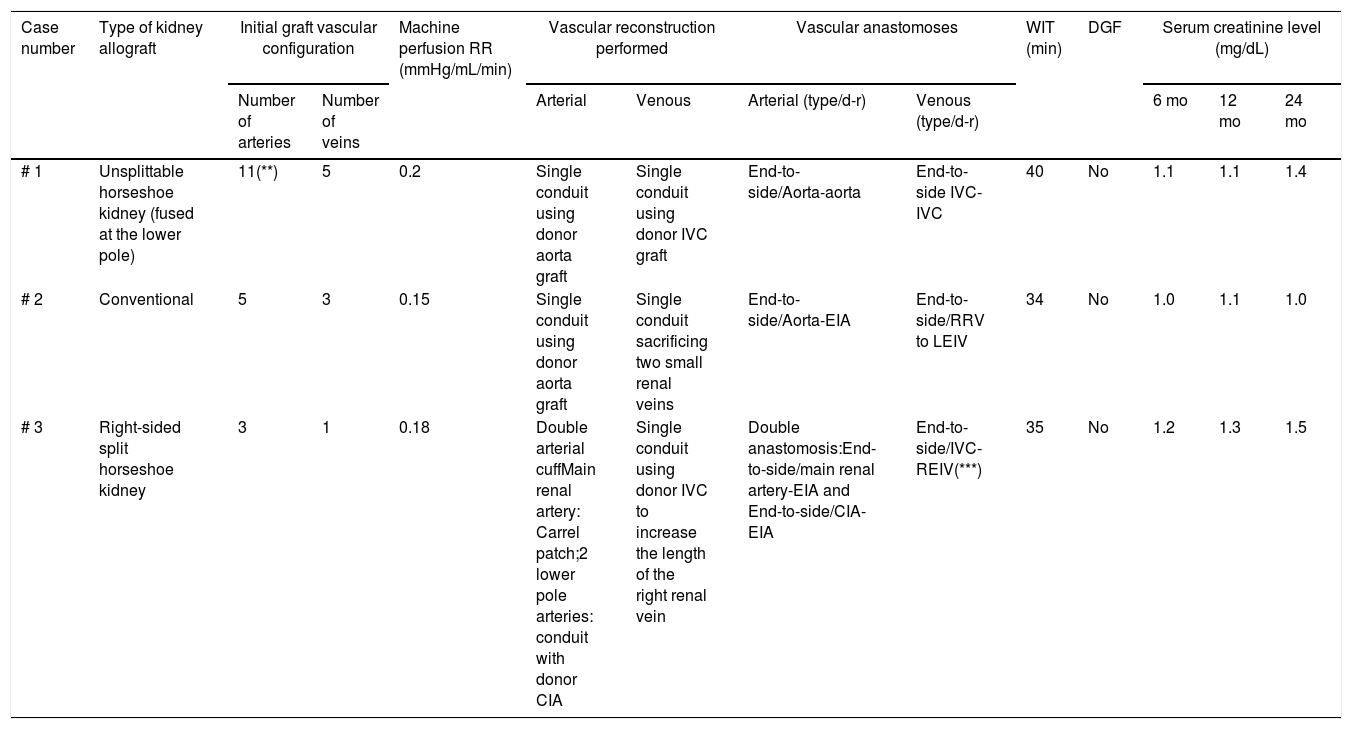Transplantation of kidneys with vascular anatomical variants remains a challenge. Due to its varying success in regard to graft function after transplantation, these organs have been frequently discarded assuming in advance an unaffordable rate of vascular complications.
Patients and methodsWe performed three kidney transplants using organs from deceased donors harboring vascular variants (multiple arteries and short veins), including an unsplittable horseshoe kidney. Different grafts harvested from the same donor aorta, common iliac artery, and inferior vena cava, were used to reconstruct the initial vascular configuration by creating single arterial and venous conduits aimed to simplify the vascular anastomoses in the recipient.
ResultsNo post-operative complications were recorded. Warm ischemia times remained comparable to single artery renal allografts. No delayed graft function was noted in any case, and every patient regained normal renal function after transplantation.
ConclusionsVascular reconstruction using arterial and venous grafts harvested from the same deceased donor may result a helpful tool to simplify vascular anastomoses during transplantation surgery, thus avoiding their discard in advance, minimizing perioperative complications, and enabling normal graft function rates in the long-term follow-up. The successful outcome obtained by using this approach would help to expand the donor criteria for the inclusion of organs containing vascular anatomical variants.
El trasplante renal con variantes anatómicas vasculares sigue siendo un desafío. Debido a su éxito variable en lo que respecta a la función del injerto después del trasplante, estos órganos se descartan frecuentemente, asumiendo de antemano una tasa inasequible de complicaciones vasculares.
Pacientes y métodosRealizamos 3 trasplantes de riñón utilizando órganos de donantes fallecidos que presentaban variantes vasculares (arterias múltiples y venas cortas), incluyendo un riñón en herradura indivisible. Se utilizaron diferentes injertos extraídos de la aorta, la arteria ilíaca común y la vena cava inferior del mismo donante para reconstruir la configuración vascular inicial mediante la creación de conductos arteriales y venosos individuales, con el fin de simplificar la anastomosis vascular en el receptor.
ResultadosNo se registraron complicaciones postoperatorias. Los tiempos de isquemia caliente fueron comparables con los de aloinjertos renales de una sola arteria. En ningún caso se observó un retraso en la función del injerto y todos los pacientes recuperaron la función renal normal después del trasplante.
ConclusionesLa reconstrucción vascular mediante injertos arteriales y venosos del mismo donante fallecido puede ser un recurso útil para simplificar la anastomosis vascular durante la cirugía de trasplante, evitando así su descarte de antemano, reduciendo al mínimo las complicaciones perioperatorias y permitiendo tasas normales de función de los injertos en el seguimiento a largo plazo. El resultado satisfactorio obtenido mediante la utilización de este enfoque ayudaría a ampliar los criterios de donantes para incluir órganos que presentan variantes anatómicas vasculares.










